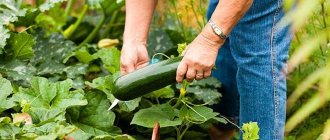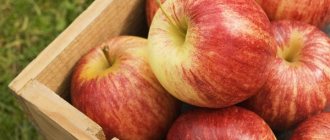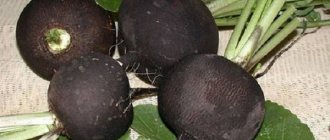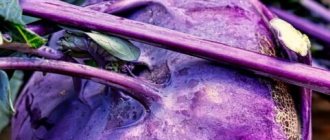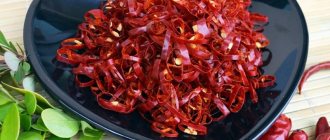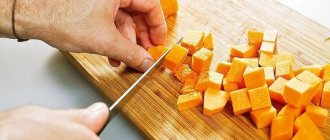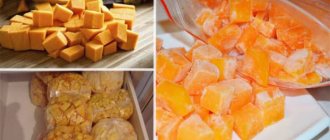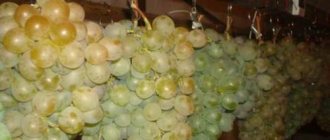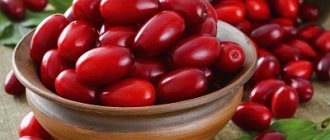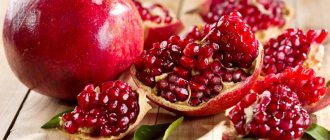Although zucchini, like pumpkin, belongs to the pumpkin family, their storage conditions have many common, key points, and many differences. Zucchini and pumpkin can be stored together if the vegetables are whole, without damage, without signs of rotting and collected on time: they will not interfere with each other during storage and there will be no risk that the disease will spread from pumpkin to zucchini and vice versa. However, it has been noted that pumpkins usually last significantly longer than zucchini, which is important to take into account when storing the fruits of these vegetable crops together and check their storage locations at least once every couple of weeks, since if the zucchini begins to rot, the rot can easily spread to the pumpkins.
Storing the zucchini harvest at home. © sweetwater-organic
In addition, it is reliably known that pumpkins can be stored at a significantly higher temperature than zucchini.
Naturally, a long period of preservation of both pumpkins and zucchini can be ensured if the harvesting technology, its preparation for storage and the storage conditions themselves, specific for the fruits of each of these crops, are correctly followed.
Important ! You should not overstay the fruits in storage; try to use them as food as quickly as possible. The longer pumpkins and zucchini are stored, the rougher they become, some of the nutrients are lost, and they can start to deteriorate at any minute, then all your work will literally go to waste, don’t forget about it.
So, let's start with how to properly store zucchini at home, and then we'll talk about pumpkin.
Harvesting zucchini for storage
As we have already noted, the key to long-term and complete storage of zucchini is timely and proper harvesting. So, as for zucchini, they must be harvested before the onset of frost (even small ones).
If the zucchini crop gets frozen, the entire batch may be spoiled and they will no longer be suitable for storage. In the very first days after storage, zucchini that has been frozen may begin to rot; it will be impossible to stop this process.
Keep in mind that the best zucchini to store will be those whose skin is quite thick, and if you knock on it, you will hear a dull sound. The seeds should not be fully developed (technical ripeness), the size of the zucchini should be medium.
There should be no damage to the surface of the zucchini; fruits with developmental defects should also be excluded from the batch intended for storage at home. Pay attention to the “pattern” on the skin: taking into account the description of the variety, you will understand whether this specimen is ready for harvesting.
Do not forget that during storage, zucchini may ripen, and as soon as this happens, their structure will become loose. Don’t be surprised that when you cut a zucchini (taking it out of the improvised storage), the seeds in it will be sprouted - this happens quite often.
When storing vegetables, you need to trim them so that a fairly large part of the stalk remains (six or seven centimeters long). In this case, the cut must be clear, namely the cut; you cannot pick the fruit by literally twisting the stalk: such fruits most likely will not be stored for a long time.
An even cut on the stalk of the zucchini and its rather long length will provide reliable protection against the penetration of microorganisms into the zucchini that can lead to internal rot. In addition, you can judge by the stalk the condition of the fruit as a whole: if it is healthy after a certain period of storage, then the fruit is most likely also healthy.
Negative changes in the stalk indicate that the fruit is also changing not for the better. In the event that even the edge of the stalk has already begun to rot, it is better to take out this fruit and use it for its intended purpose; leaving it to be stored further is a big risk.
To prevent such incidents from happening, always collect zucchini fruits in dry, sunny weather, doing it carefully, in no way damaging the surface (skin) of the fruit.
Important ! Zucchini intended for storage should not be washed, otherwise they will soon begin to rot. To rid them of dust and dirt, simply wipe them with a dry and soft cloth.
Wet vegetables also cannot be stored; they must first be dried by placing them in a ventilated area. Just a couple of hours is enough for this; you need to lay them out in one row and never stack one on top of another.
Storing zucchini in boxes. © lirsc
Zucchini and pumpkins in winter: is it possible to preserve them?
Since vegetables such as zucchini and pumpkins have tough skins, they can be stored for a long time. Today, many gardeners use simple and affordable methods for preserving these vegetables. Let's look at each of them.
What can be stored longer?
According to statistics, pumpkins have a longer shelf life. This can be partly explained by the thicker skins, which become more durable as storage time increases. The conditions for storing fresh pumpkin are similar to storing zucchini.
However, it is pumpkin that can be kept fresh and edible for a long time without losing its taste. It should be checked for the integrity of the shell before storing. Even minor damage to the peel can cause the vegetable to quickly rot.
Zucchini has a more delicate skin. It can be damaged more easily, so it is recommended to especially carefully check the condition of the skin before storing it.
Fresh storage method
Since it is preferable to store zucchini and pumpkins fresh in winter, fully mature vegetables must be stored. Fruits that are not fully ripe, but already fully formed, are perfectly preserved.
In winter, zucchini and pumpkins can be used to prepare a variety of dishes. Before laying, they should be thoroughly dried, then, depending on the size, placed in a dark and dry place; you can use breathable containers. For example, boxes made of thick cardboard, plastic containers with holes for breathing processes.
Stored vegetables should be checked regularly for spoilage. Even with a small affected area, rot spreads very quickly. If spoiled zucchini or pumpkins are not removed in a timely manner, neighboring vegetables quickly begin to rot.
Storage conditions for fresh pumpkins and zucchini in winter
You should also follow these rules to keep zucchini and pumpkins fresh in winter:
- vegetables must be cleaned of contaminants - residues of leaves, soil;
- Vegetable peels must be completely intact, without damage. Even a small scratch can cause rotting of all nearby vegetables;
- the tails of zucchini and pumpkins should be left at least 8-10 cm long. This measure will make it possible to lengthen the storage period of the fruit;
- For winter storage, it is recommended to take vegetables of approximately the same size. Sorting them by size and shape makes it easier to choose containers and storage locations;
- conditions for preserving the presentation of vegetables and their taste: stable temperature without sharp fluctuations (about 12-15 ° C), low humidity, no direct sunlight. Constant darkness is recommended. Mechanical impacts on stored vegetables should be minimal.
The listed conditions will help prevent damage to the skin of zucchini and pumpkin, deterioration in the taste and appearance of vegetables.
Many people prepare caviar from zucchini, which has a shorter shelf life than pumpkins. There are a large number of recipes for this tasty and healthy dish. The next article on our website offers an interesting and simple option for preparing caviar. It is accessible both in terms of its recipe and the possibility of preparation, even for those whose culinary abilities are by no means at a high level. You can prepare such caviar both in the fall, when the zucchini harvest is ripening, and in the winter, when the zucchini has already been stored.
One alternative to storing the listed vegetables fresh during the winter is freezing them. The freezing process is simple and does not require much time and labor to prepare vegetables. By freezing zucchini and pumpkins in winter, you can diversify your usual diet.
After all, freezing preserves most of the nutrients in vegetables. The main condition for obtaining a high-quality and tasty semi-finished product is to freeze it quickly, without re-freezing.
The process looks like this:
- Vegetables should be selected that are fully ripe, with thick, intact skin.
- The peel is peeled. If the zucchini is very young and the skin is not yet hard, then you can cut the vegetables directly with the skin for freezing.
- Next, the vegetables are cut into any shape. These can be cubes of pulp, plates, straws.
- Now portioned cut zucchini and pumpkins are placed in plastic bags or plastic containers.
- Prepared vegetables in bags or containers are placed in the freezer.
Zucchini and pumpkins in winter, when frozen, are just as tasty as fresh. They can be added to many dishes for stewing, frying, baking. The increased content of minerals and vitamins in them makes zucchini and pumpkins a valuable product in winter. Dishes made from them can be especially interesting for people who follow the rules of a healthy lifestyle. Fresh or frozen zucchini and pumpkins in winter are an opportunity to diversify the family’s diet and maintain immunity at the required level.
Although zucchini, like pumpkin, belongs to the pumpkin family, their storage conditions have many common, key points, and many differences. Zucchini and pumpkin can be stored together if the vegetables are whole, without damage, without signs of rotting and collected on time: they will not interfere with each other during storage and there will be no risk that the disease will spread from pumpkin to zucchini and vice versa. However, it has been noted that pumpkins usually last significantly longer than zucchini, which is important to take into account when storing the fruits of these vegetable crops together and check their storage locations at least once every couple of weeks, since if the zucchini begins to rot, the rot can easily spread to the pumpkins.
Basic rules for storing zucchini
The very first rule, in addition to the subtleties described above, is the right choice of zucchini variety. For example, zucchini varieties of medium and late ripening (50 days or more) are best stored. Thus, the following varieties show very good results during storage: Festival, Golden Cup, Gribovsky, Arlika (ripens in 50 - 60 days, has cylindrical, light green fruits with juicy pulp, weighing up to 700 g and good taste, is well stored), Asset, Aeronaut (ripens in 50 days, the weight of the fruit is just over a kilogram, the pattern is small dots, the color of the fruit itself is light green, the flesh is tender, stores well) and Zheltoplodny (record holder for shelf life, ripens in 50-60 days, has the fruit is cylindrical in size, weighing about one and a half kilograms with a smooth surface and an orange mesh on a yellow background, the flesh is creamy, pleasant to the taste).
However, despite the variety, even fruits with a maximum shelf life beyond the beginning of March are better not to be stored, but to be consumed before this date.
Important! When processing zucchini after storage, be sure to remove the seeds and a small portion of the pulp around them, because the seeds become bitter during storage and can impart a bitter taste to the pulp in which they rest.
Zucchini varieties for long-term storage in winter
Thin-skinned zucchini does not store well, even if you create ideal conditions for it. Therefore, if you want to eat vegetables from your garden until spring, give preference to large fruits (30-45 cm long) with thick skin and a small amount of seeds.
These characteristics are endowed with zucchini varieties Festival, Gribovsky, Zolotoy Cup, Aeronaut, Arlika, Assete F1, Aral F1, Zheltoplodny. Kuand, Marquise, Diamond, Gray, Tristan.
If the zucchini has not reached the desired size, do not store it, but use it in the fall to prepare delicious dishes
Options for storing zucchini at home
Zucchini is best stored at a humidity of 80 to 85% and at a temperature of up to five degrees Celsius and not below zero. If the temperature is high, the shelf life will be reduced to a minimum (the zucchini will simply rot). You should not store zucchini in completely dark rooms; they should lie where there is no draft. However, stale air is also not good for them; the room needs to be ventilated periodically, at least once every couple of days.
An important condition for long-term storage of zucchini is the fact that they should not touch each other. You should not store zucchini next to other fruits and vegetables, with the exception of pumpkin.
Usually, at home, zucchini is stored underground, and if it is an apartment, then on the balcony, which is periodically ventilated if it is heated, or, conversely, zucchini is insulated if the balcony is not heated, covering them with warm blankets and placing them in wooden boxes lined with foam plastic. .
You can try to store the zucchini in the pantry, laying them out on pre-designed shelves there, or hanging them like cabbage, but only placing each one in a separate net (for example, from under an onion, you can even with the remains of onion skins, it can play the role of an antiseptic).
In a box on the balcony, zucchini can be stored in dry sawdust or river sand, but to do this, you do not need to put them down, but place them vertically, placing them so that the stalks “look” up. It is advisable to place straw or sawdust in a layer of a couple of centimeters at the very bottom of the box.
If it is very cold on the balcony, then, in addition to blankets that can be used to cover the boxes with zucchini on top, they can also be wrapped in craft paper, regular newspaper or any fabric before placing them in the box.
In the case where you have the opportunity to maintain a low positive temperature on the balcony or in the basement, there are boxes and you can place the zucchini standing (so that they do not touch each other), then lay craft paper or regular corrugated cardboard between them.
It is also permissible to store zucchini as semi-finished products, this is the case if there is absolutely no space for storing them and it is impossible to provide suitable conditions. To do this, they can be cut into rings or cubes and dried, withered, or, even better, simply frozen.
Important ! Do not try to store zucchini whole in the refrigerator, they will stay there for no more than 12-15 days and will quickly begin to rot.
Conditions for storing pumpkin at home
It’s nice that pumpkin can be stored under conditions that are comfortable for you and me: that is, at a humidity of 80-85% and a temperature of up to 22 degrees Celsius. The main thing is that in the room where the pumpkin is stored, the temperature does not drop below a couple of degrees Celsius and does not go beyond zero towards frost.
The second important condition is to try to provide the pumpkin with a constant temperature without sudden fluctuations. For example, at home, place it in a storage room or on a heated balcony, if we are talking about an apartment.
The pumpkin can be stored either simply open, placing it, say, on burlap (plywood, any boards, any thick fabric or a pile of newspapers), or covered (with the same burlap); both in bulk (folded in a neat pyramid) and in boxes or paper boxes, the size of which matches the size of the pumpkin fruit.
It’s great if the pumpkin is reliably protected from sunlight and not just direct sunlight, but any kind in general, that is, it is stored in the dark.
During storage, check the condition of the pumpkin approximately once a week. If a particular fruit begins to rot, then it must be immediately removed and processed, carefully cutting it down to healthy tissue and removing the source of rot.
Harvesting pumpkin for storage
Pumpkin is a wonderful and unique vegetable that many of us underestimate. It contains, in fact, everything that the human body needs. In addition, it feels good when grown on different types of soil, sometimes even slightly swampy, in completely different climatic regions. Pumpkins can come in completely different sizes and shapes - from huge ones that are impossible for one person to lift, to the most miniature ones.
Storing the pumpkin harvest. © Danny
Let's move on to storage - as in the case of zucchini, the key to successful pumpkin storage is timely harvesting and the correct conditions for further storage. How do you know when it's time to pick a pumpkin?
It’s very simple - based on the stalk: if it begins to dry out and changes its color from green to gray, then it’s time to remove the pumpkin from the area and put it in storage.
Important ! Do not under any circumstances allow the stem to be torn off from the pumpkin fruit. This way you will dramatically reduce the shelf life of this most valuable fruit.
In order to remove the pumpkin from the site correctly, you need to slightly lift it above the ground, thereby loosening the tension of the tops and (as in the case of zucchini) cut off the fruit with a part of the stalk five or six centimeters long, and not tear it off.
The pumpkin needs to be dried: on all sides its surface should be devoid of even a hint of moisture. The slightest particles of moisture that you overlooked can subsequently become sources of rot and mold, which develop quite actively during storage.
When a pumpkin is laid dry, without damage, harvested on time and with an intact stalk, it can easily last until the next harvest.
Storing pumpkin at home. © nwedible
